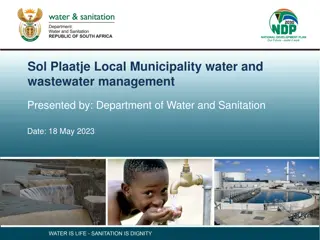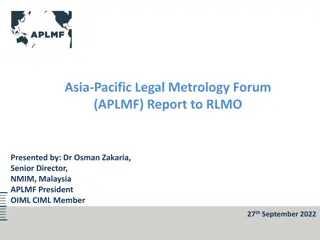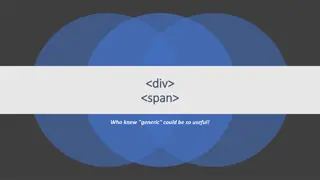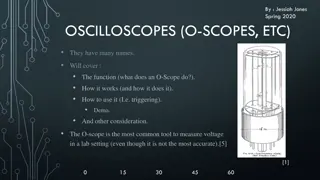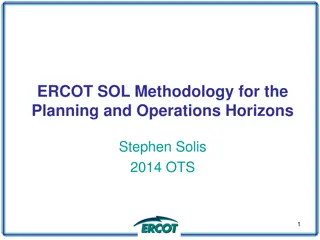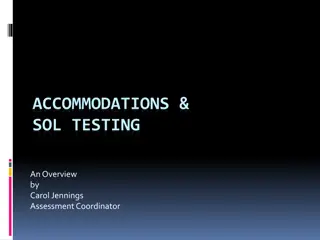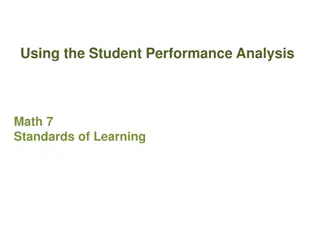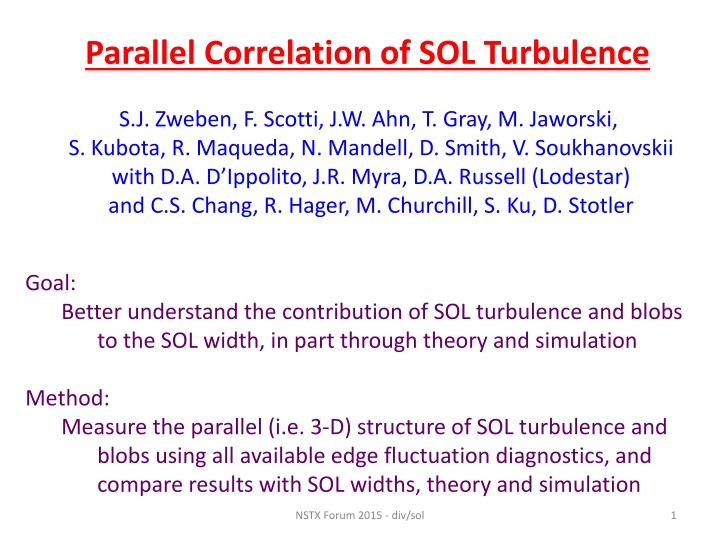
SOL Turbulence and Blobs in NSTX Forum 2015
Explore the parallel correlation of SOL turbulence and blobs in the NSTX Forum 2015, utilizing edge fluctuation diagnostics to measure turbulence structure and compare with SOL widths, theory, and simulation. Various diagnostics and tools are employed to understand SOL turbulence contribution to the SOL width. Questions on turbulence correlation along B-field lines and its impact on heat flux width are pondered for deeper insights.
Download Presentation

Please find below an Image/Link to download the presentation.
The content on the website is provided AS IS for your information and personal use only. It may not be sold, licensed, or shared on other websites without obtaining consent from the author. If you encounter any issues during the download, it is possible that the publisher has removed the file from their server.
You are allowed to download the files provided on this website for personal or commercial use, subject to the condition that they are used lawfully. All files are the property of their respective owners.
The content on the website is provided AS IS for your information and personal use only. It may not be sold, licensed, or shared on other websites without obtaining consent from the author.
E N D
Presentation Transcript
Parallel Correlation of SOL Turbulence S.J. Zweben, F. Scotti, J.W. Ahn, T. Gray, M. Jaworski, S. Kubota, R. Maqueda, N. Mandell, D. Smith, V. Soukhanovskii with D.A. D Ippolito, J.R. Myra, D.A. Russell (Lodestar) and C.S. Chang, R. Hager, M. Churchill, S. Ku, D. Stotler Goal: Method: Measure the parallel (i.e. 3-D) structure of SOL turbulence and blobs using all available edge fluctuation diagnostics, and compare results with SOL widths, theory and simulation Better understand the contribution of SOL turbulence and blobs to the SOL width, in part through theory and simulation NSTX Forum 2015 - div/sol 1
Diagnostics to Cross-Correlate with GPI 1) GPI (at outer midplane) vs. fast camera on divertor plate (Scotti), using LiI filter (like Maqueda NF 10), or other lines (D , maybe C ) Maybe use divertor gas puffing to do GPI at divertor plate, and maybe try to align B field to connect GPI and divertor camera. 2) GPI vs. divertor Langmuir probe Isat or floating potential (Jaworski). Maybe sweep OSP over probes to minimize heating. Similar to Grulke in C-Mod (NF 14), where a ~75% correlation was seen. 3) GPI vs. lower divertor tangential imaging (Maqueda), maybe with local gas puff, maybe with B field alignment. Look for X-point effects on turbulence structure and motion (like MAST APS 14) NSTX Forum 2015 - div/sol 2
SOL Turbulence Measurementscont 4) GPI vs. wide-angle fast camera view of GPI gas puff from across machine, to look for parallel motion of blobs 5) GPI vs. BES (Smith), similar to previous study (Sechrest), but maybe with improved B field alignment 6) GPI vs. reflectometer (Kubota), at least for n 1x1013 cm-3, but probably not possible to align along B field line 7) GPI vs. IRTV (Gray) using fastest possible IRTV speed; also compare SOL heat flux width to SOL turbulence properties NSTX Forum 2015 - div/sol 3
Plasma Conditions and Other Diagnostics Can do some of these correlations by piggy-backing on other XPs Dedicated shots needed for B-field alignment of GPI with divertor camera, probes, and IRTV, probably with OSP scan for probes Density scan -> OSP detachment interesting for SOL turbulence, also X-point location, snowflake, LII scan, Ip scan, RMP fields, etc. Additional useful diagnostics for SOL: Divertor spectroscopy, bolometry, and neutral density Thomson profiles at outer edge (pdf from repeated shots) Edge ion temperature, rotation, and USXR measurements Fast magnetics for separatrix magnetic fluctuations NSTX Forum 2015 - div/sol 4
Data Analysis and Interpretation Questions Is SOL turbulence highly correlated along B field line from outer midplane to divertor plate, or disconnected by shear, collisions ? How well does SOL turbulence correlate with SOL heat flux width ? Might be correlated through turbulence level, size, or radial speed. Can we use fluctuation levels to estimate turbulent vs. neoclassical transport? Does /n ~ 1 imply that neoclassical transport is small ? Theory/simulation tools: Analytic blob models for parallel correlation estimates 2-D SOLT simulations for turbulence vs. estimated SOL width XGC-a simulations for estimation of neoclassical transport XGC-1 simulations for SOL turbulence and transport NSTX Forum 2015 - div/sol 5



